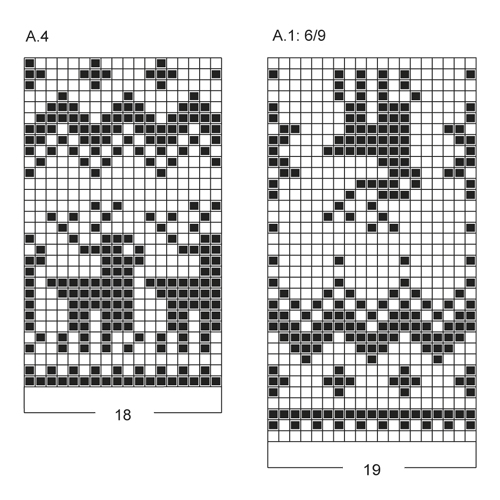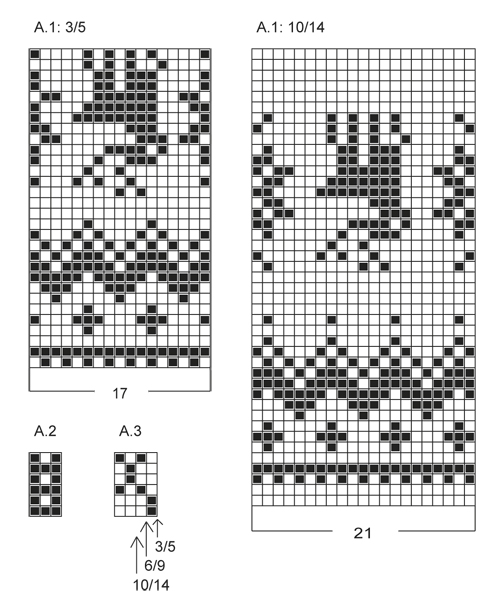Comments / Questions (7)
![]() Ingrid wrote:
Ingrid wrote:
Warum muss ich die Ohrklappen mit einem Nadelspiel stricken? Kann ich nicht einfach 2 Nadeln oder eine Rundstricknadel nehmen? Ich brauche doch nur hin und her zu stricken?
14.10.2019 - 17:40DROPS Design answered:
Liebe Ingrid, ja natürlich, die Ohrklappen werden in Hin- und Rück-Reihen gestrickt, wir haben hier mit 2 Strumpfnadeln gestrickt, denn es sind so wenig Maschen. Viel Spaß beim stricken!
15.10.2019 - 09:28
![]() Marie-Lise Soucy wrote:
Marie-Lise Soucy wrote:
Pour le bonnet est ce bien en rond parce que motif n’arrive pas. esg ce que je dois avoir une maille de plus a chaque rang?
14.03.2019 - 21:35DROPS Design answered:
Bonjour Mme Soucy, le bonnet se tricote en rond, on a 90 ou 108 m en fonction de la taille, A.4 = 18 mailles, on va donc répéter A.4 un total de 5 fois pour la première taille ou 6 fois pour la 2ème taille. Bon tricot!
15.03.2019 - 08:49Karin wrote:
"Legg opp 100-116 m..."
11.04.2015 - 17:22
![]() Marit wrote:
Marit wrote:
Karin: Men 90 masker kan ikke deles opp i 32 foran, 22 pr. øre-klaff og 24 bak.
11.04.2015 - 16:19
![]() Karin wrote:
Karin wrote:
100 m kan delas upp i 32 fram, 22 per öronklaff och 24 bak.
06.04.2015 - 08:23
![]() Marit wrote:
Marit wrote:
Det kan da ikke bli 32 masker mellom øreklaffene foran, hvis det er 22 m til hver klaff (= 44 m) og 24 m mellom klaffene bak? Det må jo bety at det er 22 m igjen mellom klaffene på forsiden??? Det er vel en trykkfeil her, er det ikke?
05.04.2015 - 20:05DROPS Design answered:
Hej Marit, jeg får 12+12 bagpå + 22+22 øreklapper + 32 foran = 100 masker.
13.05.2015 - 16:08
![]() Mamie wrote:
Mamie wrote:
Merci, toujours de beaux modèles, bravo
09.12.2014 - 12:14
Prancing Around#prancingaroundset |
|||||||
 |
 |
||||||
Knitted hat, mittens and neck warmer for children in DROPS Karisma. Pieces are worked with Nordic pattern with reindeer. Size 3 - 14 years. Theme: Christmas
DROPS Extra 0-1048 |
|||||||
|
HAT: PATTERN: See diagram A-4. Work entire pattern in stocking st. GARTER ST (back and forth on needle): K all rows. 1 ridge = 2 rows K. MITTEN: PATTERN: See patterns A-1 to A-3. Work entire pattern in stocking st. DECREASE TIP: Dec as follows 2 sts before marker: K 2 tog. Dec as follows after marker: Slip 1 st as if to K, K 1, psso. NECK WARMER: GARTER ST (back and forth on needle): K all rows. 1 ridge = 2 rows K. ------------------------------------------------------- HAT: Worked in the round on circular needle and then on double pointed needles. Cast on 100-116 sts on circular needle size 3 mm with wine red. Work rib = K 2/P 2 for 3 cm, rounds beg mid back. Switch to circular needle size 3.5 mm and K 1 round while AT THE SAME TIME dec 10-8 sts evenly = 90-108 sts. Work diagram A-4 over all sts (= 5-6 repetitions) - REMEMBER THE KNITTING TENSION. When A-4 has been worked 1 time vertically, continue with wine red until finished measurements. AT THE SAME TIME when piece measures 14-16 cm, insert 9 markers in the piece, 10-12 sts apart. On next round, dec 1 st after every marker by K 2 tog. Repeat dec every 3rd-2nd round 4-6 more times and then every 4th round 4 times = 9 sts remain on needle. Cut the yarn and pull it through the remaining sts and tighten tog. The hat measures approx. 20-22 cm vertically. EAR FLAPS: Worked back and forth on 2 double pointed needles. Count 12 sts from mid back and out to one side - insert a marker. Pick up with wine red on needle size 3.5 mm: 1 st in each of the next 22-26 sts along cast on edge. Work in GARTER ST back and forth - see explanation above! When ear flap measures approx. 3-4 cm, dec 1 st in each side by K the 2 next to last sts tog - repeat dec every other row 4-5 more times and then every row 4-5 times = 4 sts remain. Cut the yarn and pull it through the remaining sts and tighten tog. Work another ear flap on the other side of hat. There should be 24-24 sts between ear flaps at the back and 32-40 sts between ear flaps at the front. POMPOM: Make 1 dense, nice pompom with off white with an approx. diameter of 7-9 cm. Fasten at the top of the hat. MITTEN: Cast on 44-48-52 sts on double pointed needles size 2.5 mm with wine red Karisma. Work rib (= K 1/P 1) for 5-6-6 cm. Switch to double pointed needles size 3 mm and K 1 round while AT THE SAME TIME dec 4 sts evenly = 40-44-48 sts. Now measure piece from here. Continue in stocking st as follows: A-2 (= 3 sts), A-1 – choose diagram for size (= 17-19-21 sts), A-2 (= 3 sts) and then A-3 over the last 17-19-21 sts – beg A-3 at arrow for desired size. Insert 1 marker in st mid front in A-2 in one side (= thumb sts). When piece measures 1-1-2 cm, inc 1 st on each side of thumb sts, inc with wine red and work all thumb sts in wine red (not A.2) in this side. Repeat inc on every other round 3-4-4 more times = 9-11-11 thumb sts – work the inc sts in wine red. When piece measures 4-5-6 cm, slip the 9-11-11 thumb sts on 1 stitch holder. On next round cast on 1 new st behind thumb sts = 40-44-48 sts on needle - now work A.2 over the 3 sts behind thumb as before and work pattern A-1 one time vertically. Insert 1 marker in st middle of A-2 in each side. Now work mitten in wine red over all sts until finished measurements. AT THE SAME TIME on 1st round dec 1 st on each side of both markers. Repeat dec every round 7-8-9 more times - READ DECREASE TIP = 8 sts remain on needle. Cut the yarn and pull it through the remaining sts, tighten tog and fasten. The entire mitten measures approx. 17-20-23 cm. THUMB: Slip the 9-11-11 sts from stitch holder back on needle and pick in addition up 3-5-5 sts behind the thumb with wine red = 12-16-16 sts. When thumb measures 3.5-4.5-5.5 cm, work all sts tog 2 by 2. Cut the yarn and pull it through the remaining sts, tighten tog and fasten. Work another mitten but with pattern reversed. NECK WARMER: Beg at the bottom of front piece and cast off at the bottom of back piece, then lastly work the neck itself. FRONT PIECE: Cast on 46-50-54 sts on needle size 3.5 mm with Karisma and work 2 ridges in garter st - see explanation above. Continue in stocking st with 3 sts in garter st in each side. REMEMBER THE KNITTING TENSION! When piece measures 8-9-10 cm, cast off the middle 16-18-20 sts for neck. Now work each shoulder separately. Continue in stocking st with 3 sts in garter st towards the side - at the same time cast off on every row from neck: 3 sts 1 time, 2 sts 1 time and 1 st 3 times = 7-8-9 sts remain on needle. When piece measures 13-14-16 cm in total, insert a marker (= mid on top of shoulder) - now measures piece from here. On next row cast on 2 new sts towards the neck, then slip sts on a stitch holder. Work the other shoulder the same way but work 1 additional row after the 2 sts have been cast on towards the neck to finish on RS or WS on both shoulders. BACK PIECE: Work sts from one shoulder back on needle, cast on 28-30-32 sts and work sts from the other shoulder on to needle = 46-50-54 sts. Continue in stocking st with 3 sts in garter st in each side. When piece measures 13-14-16 cm from marker on shoulder, cast off all sts. NECK: Pick up approx. 76 to 90 sts around the neck on double pointed needles size 3 mm. P 1 round, then K 1 round while at the same time inc evenly to 88-96-104 sts. Continue with rib = K 2/P 2. When neck measures approx. 8-9-10 cm, cast off with K over K and P over P. |
|||||||
Diagram explanations |
|||||||
|
|||||||

|
|||||||

|
|||||||
Have you finished this pattern?Tag your pictures with #dropspattern #prancingaroundset or submit them to the #dropsfan gallery. Do you need help with this pattern?You'll find 29 tutorial videos, a Comments/Questions area and more by visiting the pattern on garnstudio.com. © 1982-2025 DROPS Design A/S. We reserve all rights. This document, including all its sub-sections, has copyrights. Read more about what you can do with our patterns at the bottom of each pattern on our site. |
|||||||


































































Post a comment to pattern DROPS Extra 0-1048
We would love to hear what you have to say about this pattern!
If you want to leave a question, please make sure you select the correct category in the form below, to speed up the answering process. Required fields are marked *.